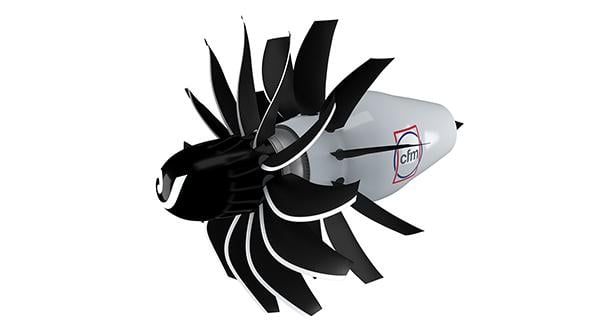
John Slattery and Olivier Andries clearly wanted to make a point when they presented their new engine research technology program this month. In the days leading up to the event, a countdown was even posted on social media channels to direct more attention to the announcement. And the CEOs of GE Aviation and Safran, respectively, were eager to highlight onstage that what they were about to reveal was not just another engine program—it would be a revolution in aviation powerplants that could help transform industry efforts to become more sustainable, therefore serving a “greater cause.”
What they presented was, of course, RISE, which stands for Revolutionary Innovation for Sustainable Engines, a technology program that is to lay the groundwork for the next generation of engines. The two partners of the CFM International consortium are looking at everything: the open fan architecture, hybrid elements, the capability to use sustainable aviation fuels (SAF) as well as hydrogen. Essentially, everything that is on the table technologically in the aircraft engine business is to be analyzed. It remains to be seen how much of this will actually become part of a new CFM single-aisle aircraft engine intended to be ready by 2035.
But it is worth looking at the messages behind GE Aviation’s press releases, as they will shape the industry in the medium term. The most important is that CFM does not want Boeing to build a new narrowbody aircraft that would enter service before 2035. The engine-maker is instead “advising” Boeing to make the most of the 737 MAX for years to come.
CFM is in a pretty comfortable position in that view: It has exclusivity on the MAX as well as a big market share of the Airbus A320neo family. Even if airlines continue to order predominantly Airbus narrowbodies for the foreseeable future, CFM will capture a large slice of that market. Although it shares the A320neo with Pratt & Whitney, there is not much downside risk.
RISE, however, puts Boeing in a much more difficult place should it want a MAX successor to enter service before 2035. Unless CFM changes plans—which seems unlikely, given the RISE publicity exercise—the Boeing aircraft would have to use Pratt or Rolls-Royce engines. For airlines, that would involve moving from one engine OEM to another, which would entail huge transition and complexity costs. The barrier would be very high.
While a larger aircraft sitting between the Boeing 737 and the 787 would require more powerful engines than today’s 737 powerplants, the RISE project also suggests that GE and Safran believe they need something radically different from the traditional architecture for aircraft that are on the drawing board.
In theory, CFM’s stance could create an early opportunity for Pratt and/or Rolls to finally get a foothold in the Boeing narrowbody market. But for the reasons described, that chance is largely theoretical. Pratt and Rolls also would face the prospect of having to compete with a next-generation engine based on the RISE research just a few years later.
For Airbus, the GE/Safran plans are quite convenient. The timeline coincides with Airbus’ own ZeroE project that is targeting service entry of a hydrogen-powered aircraft by 2035.
Whatever the engine OEMs bring to the table will be very welcome. Safran will make sure to get its share of the research budget provided by the French government to manage the transition to sustainable aviation. CFM saying to Boeing that it is focusing efforts on a new product coming in 14 years rather than something more imminent removes a potential threat for Airbus of stronger competition. Airbus can continue to manage its larger share of the single-aisle market and decide in due course whether more derivatives of the A320 family, such as the so-called A322, are necessary and promise appropriate financial returns.
The downside of the new scenario outlined by GE/Safran is that most changes in the commercial aircraft engine industry in the near term will be incremental rather than, as they assert, revolutionary.
Of course, Boeing would be more than happy to take its time in the narrowbody market, given the investment needed and the company’s high levels of debt, incurred by the 737 MAX grounding and COVID-19 pandemic. Will market dynamics allow Boeing to wait as long as GE/Safran would like?
There are some indications that they might, as momentum against an early new Boeing narrowbody may be building. United’s order for 200 more 737 MAXs—and among them 150 737-10s—was a much-needed boost. That and United’s parallel order for 70 more A321neos were also an indication from one of the world’s largest airlines that it is quite happy to continue with today’s technology for some time.


Comments
Good intentions are one thing but the physics may say something else.
Will the flying public be enamored with seeing fans spinning away outside their window after years of fully encased engine blades?